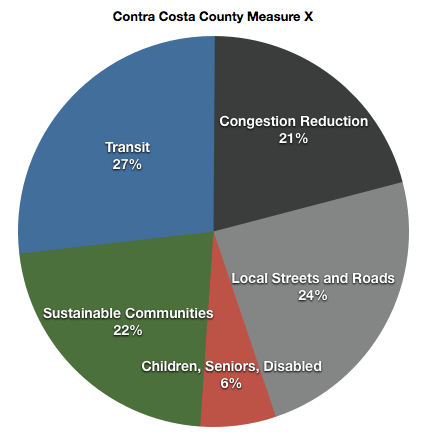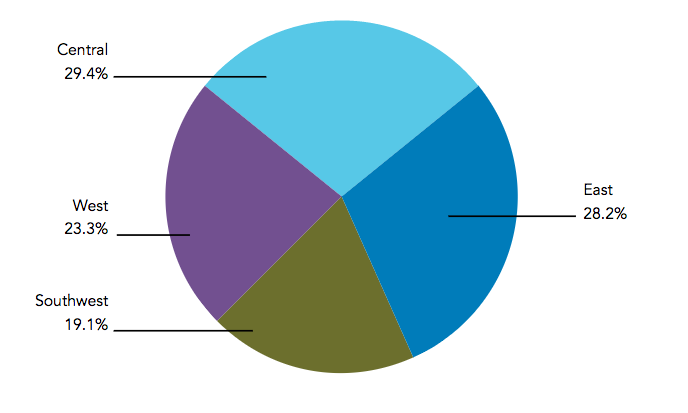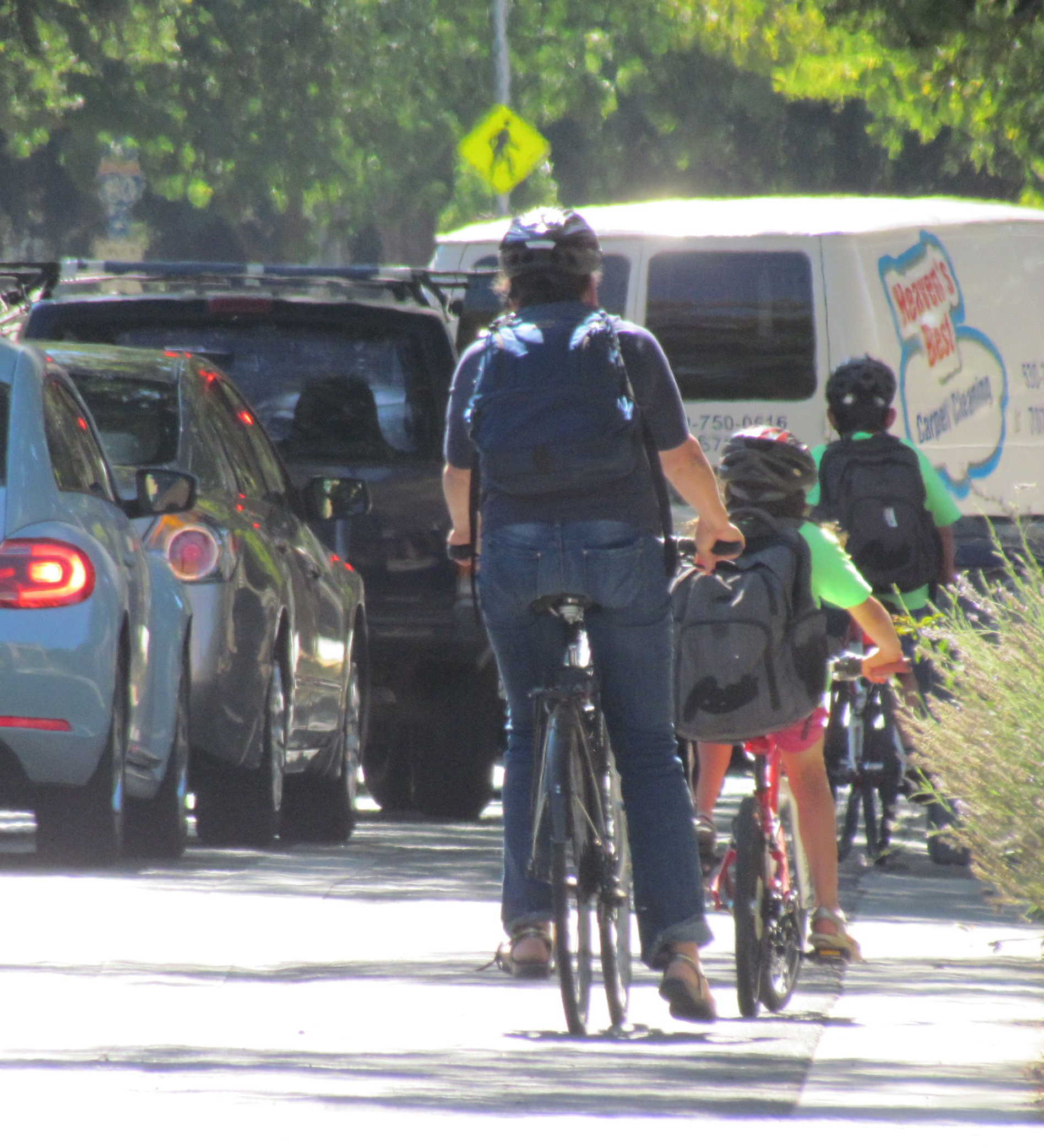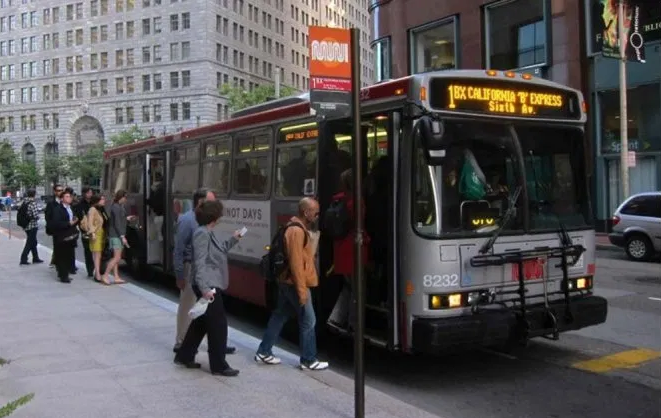Contra Costa County Transportation Sales Tax Measure X Pleases Some
4:12 PM PDT on October 20, 2016

Contra Costa County voters are considering whether to tax themselves to pay for transportation, and the plan accompanying the measure has a few potentially game-changing aspects. That doesn't mean that sustainable transportation advocates all support it, however.
Measure X, like most of the other county measures on November ballots, is a thirty-year ½ cent sales tax increase. It's expected to generate almost $2.9 billion over that period of time. It comes with a plan for how to allocate the money it raises, and will require at least 2/3 of the vote to pass.
Like other local measures, it allocates funds for both transit and roads, but Measure X also has a separate allocation for “sustainable communities,” a category that includes things like complete streets pilot projects and pedestrian and bike infrastructure. It allocates a fifth of its funding for “congestion reduction,” but language in the measure specifically calls for doing so not by widening roads but by creating alternatives for drive-alone trips.
Bike East Bay, working with several other partners including Rich City Rides, Bike Concord, and Bike Walnut Creek, is working to help pass the measure. They see big gains for bicycle and pedestrian infrastructure, including a robust “complete streets” program for major arterials, which includes almost $60 million for several pilot complete streets projects that will include accommodations for walking, biking, transit, and shuttles. That money will be distributed in the first five years of the measure, frontloading projects to test out concepts and show what can be done to make streets work better.
“People will realize we don't have to widen roads to relieve congestion, and that they can be better for everyone, including drivers,” said Dave Campbell, Advocacy Director for Bike East Bay.
In addition, a separate four percent set-aside for bicycle and pedestrian projects, is expected to run to about $115 million. Two-thirds of that amount will go to cities, and one-third to the East Bay Regional Parks District for trails and bike access.
It's less than advocates were hoping for, but they are willing to compromise for a reason: Measure X has strong language about accommodating all road users on “complete streets.” Many—or most—local jurisdictions, as well as Caltrans, have policies that encourage considering the needs of everyone, not just vehicle drivers, when transportation infrastructure is built or repaired. But Measure X goes a step further.
“Before this, the best we could get was language that said, 'You shall consider complete streets,'” said Campbell. Instead, Measure X's policy reads: “All recipients of funding through this Plan shall consider and accommodate, wherever possible [and with some well-defined exceptions], the needs of all users in the planning, design, construction, reconstruction, rehabilitation, and maintenance of the transportation system."
“This is a huge win,” said Campbell. “This will empower us when we're talking to city staff and they're hesitating about adding bike lanes or other facilities. Now they have to go to council to get an exception; we're not the ones who have to do it anymore.”
Bike East Bay and its bike advocacy partners, along with many other interest groups, were involved from early on in discussions about Measure X. Participating in negotiations around what to include gave them a perspective on the compromises that every side made to get to an agreement. Campbell is complimentary about the county transportation agency's work to get all sides to the table. “They were very inclusive and receptive to having all kinds of groups participate,” he said. “They took suggestions, and they really listened.”
“There were significant stakeholders who wanted new freeways,” said Campbell. “As the plan developed we found a series of surface-level fixes that addressed some of the main safety concerns they brought up—a small town that was suffering with freeway-like traffic cutting through it,” for example. The measure's plan will help improve a nearby road to divert the through-traffic, but it's not a freeway and it doesn't continue all the way to Tracy, which is what proponents originally wanted.
The process left Bike East Bay sanguine about the compromises they made. “Yes, we're only getting four percent, where we wanted more,” said Campbell, “but the urban limit line was not weakened, as some wanted, and no freeways will be built with this money.”
“Everybody compromised more or less equally.”
TRANSIT
More than a quarter of the measure will fund transit. That includes $300 million to help BART buy new cars, a request that BART made to every county it serves. $100 million will go towards a Community Development Program to help create infill development near transit, and $64 million will be set aside to create safe routes to schools.
And did we mention that the money that does go for freeway corridors is aimed at increasing options to driving alone, not widening the roads? That includes better bike access along the corridors, according to Bike East Bay.
But not every transportation advocacy group supports Measure X. TransForm, which advocates for rational land use and transportation decisions, has taken a neutral stance. Joël Ramos, TransForm's Regional Planning Director, says that TransForm has not been able to support the measure because the language about how the transit money will be spent is too ambiguous.
“We couldn't find the confidence to get behind it,” he said, “because theoretically we could be getting behind something that would go the wrong way.”
In particular, the allocation for transit in West Contra Costa County is too small—it is slated to receive $111 million over thirty years—and the plan does not spell out what the money is for. It could either go to operations—such as increasing service—or capital expenses, like building bus bulb outs or other projects. “That pits the two types of funds against each other,” said Ramos, “and in the past we've seen operations lose out. Capital projects tend to have ribbons that officials like to cut,” but operations money, while crucial, isn't as media-friendly.
The problem is that West Contra Costa County, where the city of Richmond lies, has poor existing bus service. Yet it is one of the denser parts of the county, and it is home to many low-income folks who sometimes have no other choice but to rely on the bus.

“What pushed us over,” said Ramos, “is that Measure X is a sales tax, and thus regressive,” meaning that everyone pays the same amount of tax on purchases, so low-income people end up paying a larger portion of their income than people of means. “The amount of bus service in Richmond is not viable for people who don't have a choice—AC Transit buses have at best thirty-minute headways along corridors as dense as any in Oakland,” where buses more typically run fifteen or twenty minutes apart at most. Focus on increasing that service is crucial.
“This is something a sales tax shouldn't be neglecting,” he said.
TransForm recognizes that there is plenty in Measure X that is worthy of support—it's “a boon” for bikes and pedestrians, and TransForm is proud of having helped negotiate some of that, said Ramos. “If it was only about that line of funding, we would be cheering this on.”
The lack of attention to bus service in Richmond is a reflection of how hard it is to see transit from an equity perspective. “It's intuitive to support transit from an environmental perspective,” said Ramos. “But we have to look at the equity impacts--it's our job. While we'd love for BART to be made convenient with this funding, it's our charge to shine a light on what's happening in West County.”
OPPOSITION
The local service labor organization, AFSCME Council 57, opposes the measure for similar reasons. Cheryl Brown, the local council's political and legislative director, said that the measure is a long-term, regressive tax that will shift funding away from bus service and from parts of the county where “we know people will take the bus and where there's a greater economic need.” Measure X money will help higher income commuters than folks who commute a long way after hours to, for example, clean offices.
Brown described one of the workers represented by her union, who lives in Pittsburg and works in Martinez—a distance of roughly ten miles. “She takes three different lines to get to work: a TriDelta bus, then BART, then County Connection. That's three different fares, at a huge cost. There's also the inconvenience of time and connection,” she said. “She gets to work an hour early because if she misses a connection or the bus is late, she gets written up” by her boss.
While AFSCME supports some of the measure's plan, including the bicycle and pedestrian investments, she says that, ultimately, “there's too much investment in potholes and in helping more affluent commuters. They do suffer—they have to drive those roads during rush hour—but it's a different kind of suffering than waiting for a bus without shelter.”
Like other similar sales tax proposals, Measure X reflects the difficulty of creating a funding plan that a diverse community can support. Because these measures tax everyone equally, organizers need to create a plan that has at least a semblance of equal distribution. Yet it is harder to explain and account for equity, which is not the same as equality.
And because these measures need support from 2/3 of voters, they need to somewhat reflect “the will of the people.” But what that will is, and how it gets defined is up to the political processes that produce it.
Whether Measure X passes or fails, sustainable transportation and equity advocates will still have plenty of work to do.
Streetsblog California editor Melanie Curry has been thinking about transportation, and how to improve conditions for bicyclists, ever since commuting to school by bike long before bike lanes were a thing. She was Managing Editor at the East Bay Express, editor of Access Magazine for the University of California Transportation Center, and earned her Masters in City Planning from UC Berkeley.
Stay in touch
Sign up for our free newsletter
More from Streetsblog California
Active Transportation Program Calls for Volunteer Evaluators
Apply to be a volunteer ATP application evaluator by May 10.
Study: When Speed Limits Rise on Interstates, So Do Crash Hot Spots on Nearby Roads
Rising interstate speeds don't just make roads deadlier for people who drive on them — and local decision makers need to be prepared.
Eyes on the Street: New Lincoln Park Avenue Bike Lanes
The recently installed 1.25-mile long bikeway spans Lincoln Park Avenue, Flora Avenue, and Sierra Street - it's arguably the first new bike facility of the Measure HLA era
Independent Safety Advocates Beef up the Wiggle
Signs and soft-hit posts installed by advocates make the Wiggle bike route calmer and safer for cyclists and pedestrians
Thursday’s Headlines
LA Metro declares emergency over attacks on bus operators; Some deadly Bay Area streets to see safety fixes; Tax ride-hail to save transit? More




